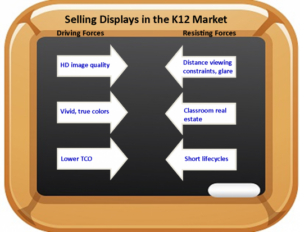In last month’s article, Large Displays and the Education Market (1), I suggested some surprising trends visible at the first three ed-tech conferences of the season: that interactive large displays outpaced the number of booths featuring interactive whiteboards; that booths featuring large display solutions outnumbered projector company booths; and that Interactive large displays were being pushed in three formats for education: mounted displays, rolling displays, and in-table displays.
To a number of on-the-floor observers with whom I spoke, a major shift seemed under way. My concluding question was this: “Does this mean that education market penetration will become a slam dunk for the large display industry?” I suggested that the answer was “no.” In this follow up article, I will explain why it will require a finesse game and smart moves to reach the K-12 market in the U.S. with large displays, interactive or otherwise.
Why am I so certain that the road will be rougher than it seems? Let’s look at my own state. In Colorado, we have more than 168 school districts, large and small. How many of those districts have installed large display solutions in every classroom, as opposed to mounted or carted projectors? The answer: “one small district.” The other districts all use projectors in classrooms. How can we explain this?
As educational technology leaders, we respect the challenge of implementing technological change. It isn’t easy. For that reason, we often engage in a careful analysis of the forces opposing major innovation efforts, so we can increase the likelihood of success. One technique we use is force field analysis. With force field analysis, one considers (before the implementation begins) the driving forces, those forces working in favor of our desired change. Then we begin to expose the forces that work ferociously against our best intentions. These are called resisting forces. A force field analysis of the challenges of deploying large display monitors in K-12 educational setting is telling:
Driving Forces
Over the years, my K-12 colleagues who strongly support the use of large displays in the classroom offer the following advantages in their arguments:
Sharp, clean HD images and video. The visual strength of display monitors is obvious. This is especially important to science educators, followed by art and social studies educators. Image quality matters to these folks.
Vivid and true colors. The vivid color advantage of large displays is inarguable. Again, the above categories of educators find this advantage to be highly desirable.
Low Total Cost of Ownership (TCO). Low initial cost—plus no recurring expenses for bulb or filter replacement costs—entice educators with a clear economic advantage over the long haul. Interactive displays offer additional lower cost of ownership over having to buy both a projector and an interactive white board.
Resisting Forces
School customers who favor the use of projectors often resist the purchase of large displays in classrooms for the following reasons:
Glare. Many U.S. classrooms have plenty of window; school architects embrace the light. This presents limitations on where displays can be mounted to prevent glare.
Short lifecycles. Most DLP projectors have a 7-10 year life in the classroom before they are replaced. The large display solution should be able to match this, but cheaper parts and components can often make this touchy replacement issue grow into a deal killer for schools.
Distance viewing constraints. Face it. In spacious U.S. classrooms, students cannot see instructions, labels, website details, or important detail on a typical large display when sitting in the last two rows of a classroom. Neither can they see well when sitting on the extreme right or left edges of our wide-angle U.S. classrooms. Only a 90″ screen can guarantee readability. That raises costs. Of course, the problem can be solved with multiple displays, but then that doubles the cost of installation and procurement.
Precious classroom real estate. This is the big issue, really. Space wars. The scarcest resources in any classroom are wall space and floor space. (Projectors use ceiling space.) Anyone involved in school design knows this problem well. I have been on the design team for nine new construction schools and over twenty-six major school remodeling projects, and this issue is always a challenge. Placing rolling or in-table large displays in classrooms competes with student and teacher desks, tables, bookshelves, learning centers, lab stations, or other obligatory classroom furniture. Placing large displays on walls competes with closet and storage space, whiteboard space, windows, doors, bookshelves, walls used for the display of student work or instructional materials, communication systems, sinks with counters, and sometimes odd angles. You get the idea. In many classrooms, installing large displays is a tough sell.
I hope this article goes a long way in explaining why large display sales–large tenders– will not be a slam dunk in the education market in the US. It will be tough to gain the kind of penetration seen by projectors. But don’t give up. One of the processes used with force field analysis is a careful analysis and planning for lessening the obstacles, the resisting forces, to any deployment. I would always sit down with my staff and identify specific ways to weaken or remove these obstacles. That is your challenge in reaching the education market. Selling large displays is not impossible. The right mashup of solutions, mountings, display placement, strategies, and verbiage can make real inroads in selling to schools. It just takes insight, hard work, and clever thinking.
In higher education, where the funding is vastly higher than what is seen in K12, it is a completely different matter. Selling multiple displays per classroom is commonplace. Understanding these cultural and logistical dynamics of selling displays in the education market should help you in reaching your goals. – Len Scrogan

